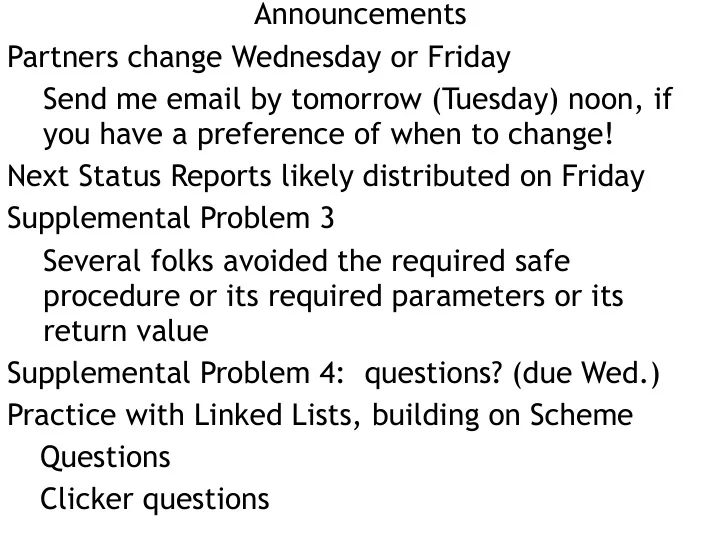

Announcements Partners change Wednesday or Friday Send me email by tomorrow (Tuesday) noon, if you have a preference of when to change! Next Status Reports likely distributed on Friday Supplemental Problem 3 Several folks avoided the required safe procedure or its required parameters or its return value Supplemental Problem 4: questions? (due Wed.) Practice with Linked Lists, building on Scheme Questions Clicker questions
Preliminaries: A list is often denoted as a sequence of items in parentheses List A: (Donna Jeff Jackson Hannah) List B: (2 7 1 8 2 8) List C: ( ) Lists may be represented by box-and-pointer diagrams: Donna A Jeff Jackson Hannah Items on a list are called nodes. What are the proper box-and-pointer diagrams for Lists B and C? 2 7 1 8 2 8 I B II B 2 7 1 8 2 8 III C Options: A. I and III B. I and IV C. II and III D. II and IV IV C [null] E. Something else
Suppose A is the list (Donna Jeff Jackson Hannah) In some languages, car (A) is a function that returns the first item on A (e.g. Donna) cdr (A) returns the rest of the list (e.g., (Jeff Jackson Hannah)) Now suppose B is defined as follows: 2 7 1 8 3 9 B What is returned by car(cdr(cdr(cdr(B)))? A. 2 D. the list (8 3 9) or (3 9) B. 7 or 1 E. something else C. 8 or 3
Suppose A is the list (Donna Jeff Jackson Hannah) In some languages, car (A) is a function that returns the first item on A (e.g. Donna) cdr (A) returns the rest of the list (e.g., (Jeff Jackson Hannah)) Now suppose B is defined as follows: 2 7 1 8 3 9 B What is returned by cdr(cdr(cdr(cdr(B)))? A. invalid expression D. the list (8 3 9) B. 2 or 7 or 1 E. the list (3 9) or (9) C. 8 or 3 or 9
Suppose A is the list (Donna Jeff Jackson Hannah) In some languages, car (A) is a function that returns the first item on A (e.g. Donna) cdr (A) returns the rest of the list (e.g., (Jeff Jackson Hannah)) Now suppose B is defined as follows: 2 7 1 8 3 9 B What is returned by car(cdr(car(cdr(B)))? A. invalid expression D. the list (8 3 9) B. 2 or 7 or 1 E. the list (3 9) or (9) C. 8 or 3 or 9
In C, a node may be defined as struct node { int data; struct node * next; } Suppose B is declared as a struct node * and B points to the first element of the following list: 2 7 1 8 3 9 B What is printed by the following: printf ("%d\n", (*(*(*B).next).next).data); 1. 2 5. something else 2. 7 3. 1 4. 8
What is printed by the following code, assuming B points to the first node in the list: struct node * ptr = B; printf ("("); while (ptr != NULL) { printf (" %d", (*ptr).data); ptr = (*ptr).next; } printf (" )\n"); 2 7 1 8 2 8 B A. ( 2 7 1 8 2 8 ) C. ( 7 1 8 2 ) E. None of the B. ( 2 7 1 8 2 ) D. possible compile above or run-time error
Recall: ptr->data is an abbreviation for (*ptr).data ptr->next is an abbreviation for (*ptr).next What is printed by the following code, assuming B points to the first node in the list: struct node * ptr = B; printf ("("); while ((*ptr).data != NULL) { printf (" %d", ptr->data); ptr = (*ptr).next; } printf (" )\n"); 2 7 1 8 2 8 B A. ( 2 7 1 8 2 8 ) C. ( 7 1 8 2 ) E. None of the B. ( 2 7 1 8 2 ) D. possible compile above or run-time error
What is printed by the following code, assuming B points to the first node in the list: struct node * ptr = B; printf ("("); while (ptr->next != NULL) { printf (" %d", (*ptr).data); ptr = ptr->next; } printf (")\n"); 2 7 1 8 2 8 B A. ( 2 7 1 8 2 8 ) C. ( 7 1 8 2 ) E. None of the B. ( 2 7 1 8 2 ) D. possible compile above or run-time error
Recommend
More recommend